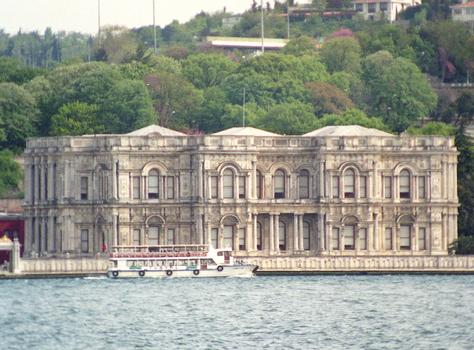General Information
Project Type
| Function / usage: |
Palace |
|---|---|
| Architectural style: |
Ottoman Second Empire |
Location
Technical Information
There currently is no technical data available.
Excerpt from Wikipedia
The Beylerbeyi Palace (Turkish:Beylerbeyi Sarayı), Beylerbeyi meaning "Lord of Lords", is located in the Beylerbeyi neighbourhood of Üsküdar district in Istanbul, Turkey at the Asian side of the Bosphorus. An Imperial Ottoman summer residence built in the 1860s, it is now situated immediately north of the Bosphorus Bridge. It was the last place where Sultan Abdulhamid II was under house arrest before his death in 1918.
History
Beylerbeyi Palace was commissioned by Sultan Abdülaziz (1830–1876) and built between 1861 and 1865 as a summer residence and a place to entertain visiting heads of state. Empress Eugénie of France visited Beylerbeyi on her way to the opening of the Suez Canal in 1869. Empress Eugénie of France was so delighted by the elegance of the palace that she had a copy of the window in the guest room made for her bedroom in Tuileries Palace, in Paris. Naser al-Din Shah Qajar of Iran stayed in the palace while he was in Istanbul, back on his way from Exposition Universelle (1889) of France. Other regal visitors to the palace included the Duke and Duchess of Windsor.
The palace was the last place of captivity of the deposed sultan Abdulhamid II from 1912 until his death there in 1918.
Description
Designed in the Second Empire style by Sarkis Balyan, Beylerbeyi Palace seems fairly restrained compared to the excesses of the earlier Dolmabahçe or Küçüksu palaces.
The palace looks its most attractive from the Bosphorus, from where its two bathing pavilions, one for the harem (women's only) and the other for the selamlik (men's only), can best be seen. One of the most attractive rooms is the reception hall, which has a pool and fountain. Running water was popular in Ottoman houses for its pleasant sound and cooling effect in the heat.
Egyptian reed matting is used on the floor as a form of insulation. The crystal chandeliers are mostly French Baccarat and the carpets are from Hereke.
Text imported from Wikipedia article "Beylerbeyi Palace" and modified on 23 October 2020 according to the CC-BY-SA 3.0 license.
Participants
- Sarkis Balyan (architect)
Relevant Web Sites
Relevant Publications
- (2015): Seismic evaluation and structural control of the historical Beylerbeyi Palace. In: Structural Control and Health Monitoring, v. 22, n. 2 (February 2015), pp. 347-364.
- About this
data sheet - Structure-ID
20028281 - Published on:
03/06/2007 - Last updated on:
30/07/2014





